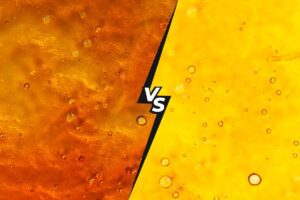What does CBD Oil taste like?
CBD — short for Cannabidiol — is the active ingredient in your hemp oil. But CBD itself doesn’t taste much like anything contrary to popular belief. In its purest form, CBD isolate is a crystalline powder that’s flavorless and odorless.
So what does CBD oil taste like, then? Where does the flavor come from?
Phytonutrients, of course! These are naturally occurring cannabis plant medicines that make their way into your CBD extract. Phytonutrients give CBD its distinctive cannabis flavor by interacting with the taste buds in your mouth and the smell receptors in your nose.
The three main types of phytonutrients in CBD oil are terpenes, flavonoids, and polyphenols. They can taste sweet, sour, bitter, floral, nutty, spicy, and even metallic. The specific phytonutrients in your CBD extract and their ratio to each other determine what CBD oil tastes like.
Cannabiva® brand CBD oil has a blend of phytonutrients that impart a lightly sweet, delicately floral cannabis bouquet with just a hint of grassiness. It’s perfectly balanced and always goes down smoothly, leaving a delightfully bright hemp aftertaste.
Let’s take a closer look at how these common phytonutrients work to give your CBD oil its one-of-a-kind flavor.
Terpenes in CBD
Cannabis research has identified over 200 terpenes responsible for what CBD tastes like. Another name for terpenes is essential oils. They can evoke the freshness of an alpine forest, the creaminess of a tropical coconut paradise, or the citrusy sweetness of an orange grove.
Terpenes interact with each other to affect the taste and aroma you experience from taking CBD. On their own, they might not have much oomph. Combine a multitude of terpenes, though, and you get a veritable symphony of the senses. The exact composition of terpenes and their ratio is what makes CBD oil taste sweet, floral, herbaceous, grassy, woodsy, fresh, piney, spicy, nutty, and a whole lot more.
Five primary terpenes are predominant in all CBD extracts. They are myrcene, limonene, pinene, caryophyllene, and humulene. How these five terpenes are balanced in relation to each other depends on the cannabis strain used to make your CBD oil. In addition, secondary terpenes in your CBD enrich the fragrance to create a beautifully complex CBD oil taste all its own.
Mycerene
Myrcene is the dominant terpene in cannabis hemp. Dominant, in this case, means myrcene is the most abundant. Myrcene has a distinct aroma best described as earthy and herbaceous with a hint of clove and a glimmer of citrus and tropical fruit. Some people describe myrcene as slightly peppery, while others have noted its subtle sweetness and fruitiness. Along with cannabis, myrcene is found in hops, lemongrass, mangoes, and thyme.
Limonene
Citrus-forward limonene is a zesty fragrance you’ll recognize instantly. Its aroma can range from tart and tangy to sweet and mellow. The bright, uplifting scent of limonene is found in cannabis and many different fruits and herbs, including lemons, grapefruit, spearmint, rosemary, and juniper berries.
Pinene
Pinene is simultaneously floral, earthy, woodsy, and piney fresh. There’s also just a touch of grassy sweetness to it, like a summer day in the heights of the alpine air. Some people pick up slightly herbaceous and minty undertones from pinene. Pine needles are the best place to find pinene. But you’ll also find it in fruits and herbs, like juniper berries, cilantro, sage, eucalyptus leaves, dill, basil, and cannabis.
Caryophyllene
Caryophyllene has a black pepper zing wrapped in a warm, soothing blanket of clove spice. Subtle fruity citrus hints lend a delicate sweetness to the mix. Some people describe caryophyllene as having an herbaceous and musky undertone. Many herbs and spices have caryophyllene, including black pepper, cloves, cinnamon, bay leaves, oregano, hops, and cannabis.
Humulene
Humulene has a slightly bitter, woody scent with a tiny kick of spice. It’s the primary terpene you smell in a freshly tapped beer. Some people detect a subtly sweet aroma emitted by humulene. Cannabis and other herbs, spices, and vegetables have humulene in them. The fragrance of hops, for example, is almost entirely made up of humulene. You’ll also find it in sage, ginseng, cloves, black pepper, basil, oregano, and carrots.

KEY TAKEAWAY
Terpenes meld taste and aroma to give your CBD its one-of-a-kind flavor. Cannabis research has identified over 200 terpenes, including five predominant ones called myrcene, limonene, pinene, caryophyllene, and humulene. Terpenes may taste sweet, floral, herbaceous, grassy, woodsy, fresh, piney, spicy, nutty, or peppery. The exact composition of terpenes and their ratio is what makes your CBD oil taste uniquely delightful.
Flavonoids in CBD
Everyone talks so much about CBD taste from terpenes that they forget all about flavonoids! Sadly, these tiny molecular miracles really don’t get enough credit for the heavy lifting they do when it comes to the way CBD oil tastes.
Flavonoids are part of a larger group of phytonutrient compounds called phenolics. But they’re far from exclusive to cannabis, with over 10,000 flavonoids found in various fruits, vegetables, herbs, spices, and other plant-based food and drink.
Scientists have identified over 25 flavonoids in cannabis, accounting for about 2.5% of the dry weight of the plant’s leaves and flowers. Flavonoids are natural pigments that give color to cannabis and affect what CBD oil looks like. They also add a more complex flavor dimension to influence what CBD oil tastes like. We must examine the molecular structure of flavonoids to gain insight into how they add depth to CBD oil taste.
Your taste buds have special protein receptors belonging to G protein-coupled receptor family T2R38. These receptors detect bitter flavors. The molecular structure of some flavonoids allows them to interact with these taste receptors when they bind. It’s the reason why many flavonoids have a slightly bitter aftertaste.
Some flavonoids have a sharp or astringent taste, leaving your mouth dry and puckery. Still, others taste sweet. Isoflavones are a type of flavonoid that may taste like nothing at all.
Ratios of flavonoids in different cannabis plant strains vary, so expect taste differences between CBD brands depending on the strain they use. Organica Naturals CBD, for example, has a rich, bold cannabis flavor, versus Cannabiva CBD Oil, which has a light and floral zesty sweetness. Zero High® brand CBD products are unique altogether because they are single-molecule isolate infusions that are completely odorless and flavorless.
The five dominant flavonoids in CBD extracts are called cannflavins A/B/C, quercitin, apigenin, kaempferol, and orientin.
Cannflavin A/B/C
The cannaflavin group of flavonoids is almost exclusively found in cannabis, so its flavor properties have not been extensively studied compared to more common flavonoid compounds. The way cannaflavins taste — if they have one — is likely influenced by the specific cannaflavin combination, its interaction with other flavonoids, and individual taste preferences.
Quercetin
Quercetin is the most abundant flavonoid in our diets. You’ll find it in dozens of plant-based foods, including fruits, vegetables, teas, grains, nuts, seeds, and medicinal herbs like cannabis. Quercetin has a bitter or astringent taste.
Kaempferol
Saffron and capers have the highest concentration of kaempferol. Cannabis is another source of it. But kaempferol is widely distributed in many different foods of plant origin. Spinach, kale, cucumbers, green beans, and broccoli are fruits and vegetables with the most kaempferol per serving. Kaempferol tastes slightly bitter or astringent.
Apigenin
Chamomile flowers contain the most apigenin of any other plant foods by far — over 68%! It’s also found in fruits and vegetables, like oranges, bell peppers, tomatoes, cabbage, wheat sprouts, and cannabis. Apigenin is mildly bitter and astringent.
Orientin
Besides cannabis, orientin is found in many fruits, vegetables, seeds, and grains. Cucumbers, corn, soybeans, wheat, red rice, and quinoa are all sources of orientin. High concentrations of orientin may produce a sharp, bitter flavor that is mildly astringent.

KEY TAKEAWAY
Flavonoids never get the credit they deserve when it comes to their effect on what CBD oil tastes like. But flavonoids add depth and complexity to CBD oil taste. Cannabis researchers have identified over 25 flavonoids in cannabis, including cannflavins A/B/C, quercitin, apigenin, kaempferol, and orientin. Flavonoids may taste slightly bitter, astringent, or sweet.
Other Polyphenols in CBD
Polyphenols are a very diverse class of phytonutrients. They include the flavonoids we discussed above but encompass so much more. Cinnamic acid, caffeic acid, ferulic acid, and tannins like catechin are the most common polyphenols that contribute to the flavor dimension and taste of CBD oil. They are the same sharp, bitter-tasting compounds in coffee, tea, and wine.
Cannabis has up to 15 milligrams (mg) per gram (g) of dry-weight polyphenol content, making it one of the highest sources compared to most other plant-based foods. Consequently, you may notice a more prominent bitter or sharp component in CBD oil, especially if it’s a high-potency product like 5000 mg CBD Oil or 12,000 mg CBD Oil.
Polyphenols have a very similar molecular structure to flavonoids, allowing them to bind to G-coupled protein receptor sites on your tongue and mouth. How polyphenols affect CBD oil taste depends on the cannabis strain used because the ratio of polyphenols varies between plant strains. Expect significant taste differences between CBD brands for this reason.
Let’s explore the characteristics of the five dominant polyphenols that may affect what CBD oil tastes like below.
Cinnamic acid
Cinnamic acid has a honey-like aroma. It serves as a precursor to sweet-smelling esters with pleasant, long-lasting scents. Cinnamic acid is obtained from cinnamon, citrus fruits, grapes, spinach, celery, broccoli, cocoa, tea, and cannabis.
Caffeic acid
Caffeic acid is most commonly found in coffee, producing a bitter taste reminiscent of roasted espresso. It’s also in cannabis, herbs, fruits and vegetables, grains, spices, and wine.
Ferulic acid
Ferulic acid produces a slightly bitter sensation on the tongue, similar to the taste of vegetables like broccoli and spinach, but it may also come with a slightly sweet aftertaste. Cannabis contains ferulic acid, as do many whole grains, fruits, nuts, herbs, and spices.
Catechin
Catechin is a tannin characterized by its slightly bitter and astringent taste. It’s found in various plant-based goods, including fruits, cocoa, tea, wine, and cannabis. Catechin is why tea steeped for too long or at too high a temperature tastes more bitter.
Other Tannins
Tannins bind with proteins in saliva to produce a “dry,” puckering, mouth-coating sensation similar to the feeling from drinking over-steeped tea or eating unripened fruit. In wine, for example, tannins contribute to its structure, complexity, and ability to age, but too much tannin can make a wine taste harsh or overly astringent. The same goes for the taste of CBD oil. Cannabis, tea, spices, and wine are common sources of tannins. So are fruits, nuts, and legumes.

KEY TAKEAWAY
Polyphenols have a similar molecular structure to flavonoids, so they may taste sharp, astringent, or bitter. How polyphenols affect CBD oil taste depends on their ratio and varies between cannabis plant strains. Cinnamic acid, caffeic acid, ferulic acid, catechin, and other tannins are the dominant polyphenols that affect what CBD oil tastes like.
What affects the way CBD oil tastes?
CBD oil offers an array of different flavors, from earthy to fruity to fresh — but what affects the way CBD oil tastes?
Everything right down to the location where the cannabis was planted, soil characteristics, elevation, and climate may influence the way CBD oil tastes. Factors like the harvest method, extraction process, carrier oil used, and formula potency bring their nuances to the flavor of your CBD oil, too.
Where CBD is grown
CBD oil can have a range of flavors depending on how it is grown. Terroir — the environment in which cannabis is cultivated — has an enormous influence on the taste of CBD oil. Factors such as soil type and nutrient content, elevation, and climate all affect what CBD oil tastes like.
Organic farming practices are essential for growing quality CBD-rich cannabis. They result in desirable phytonutrient profiles that give off pleasant aromas and tastes. Organic CBD farming ensures that soils are healthy and plants are grown without chemical fertilizers or pesticides that could contaminate them. Organic CBD oil is the way to go if you’re looking for the best tasting full spectrum CBD oil.
The right combination of sunlight and temperature also affect the way CBD oil tastes. For example, hemp grown outdoors is more flavorful than indoor-grown hemp due to environmental factors like soil composition, direct sunlight exposure, temperature variations throughout the day/night cycle, etc. Likewise, plants grown at higher altitudes can have more intense flavor due to their exposure to colder temperatures than those in warmer areas.
Additionally, different harvesting techniques can affect both phytonutrient ratios and overall flavor profiles depending on when the plant is harvested during its life cycle (e.g., early vs. late harvest).
How CBD is harvested
The way your cannabis is harvested is vital and significantly affects the way CBD oil tastes.
Hand-harvested cannabis makes the best tasting CBD oil because it protects delicate plant medicines and VOCs (volatile organic compounds) encapsulated in the leaves and flowers. The entire plant is kept intact and unbroken during hand-harvesting, which adds a great deal of fullness and richness to your CBD oil. Machine harvesting, on the other hand, often tears or damages plant tissues, reducing their potency, effectiveness, and flavor profiles. Always check with your CBD manufacturer to make sure they hand-harvest their plants.
The timing of cannabis harvest in its life cycle is essential in how CBD tastes. Older leaves, for example, contain fewer terpenes than younger ones. Some phytonutrients may degrade into unpleasant tasting compounds like skunkiness or earthiness if harvested too late. That could make your product less palatable than if harvested earlier in its life cycle when it contains more aromatic compounds like limonene or myrcene.
CBD extraction method used
There’s more than one way to extract CBD from cannabis, and each extraction method uniquely affects how CBD oil tastes. Three primary methods dominate the CBD extraction landscape: subzero ethanol extraction, C02 gas extraction, and steam distillation.
Subzero ethanol extraction produces the boldest, best-tasting CBD oils. It is the preferred technique if you want a CBD oil taste that’s out of this world amazing. Subzero ethanol extractions have the most terpenes, flavonoids, and polyphenols because the below-zero temperatures used in the process protect them from breaking down. That’s why sugarcane ethanol extracts of CBD are so rich and flavorful compared to other methods.
C02 gas extraction is another popular process used in CBD manufacturing. This extraction method uses pressurized carbon dioxide at low temperatures to separate cannabis compounds. C02 gas extraction may tear the terpenes or otherwise damage some of the more fragile phytonutrients in cannabis, which could degrade the CBD oil taste profile. C02 gas-extracted CBD oil typically tastes much lighter than its subzero ethanol counterpart.
Steam distillation is yet another form of CBD extraction that uses heat instead of pressure or solvents as part of the process. The way CBD oil tastes when it’s processed using steam distillation is the lightest of the three most common extraction methods.
The ratio of phytonutrients between extraction methods varies, so expect taste differences between CBD brands. Organica Naturals CBD, for example, is made with a single-pass organic sugar ethanol process that uses subzero extraction temperatures to protect the flavonoids and other fragile plant medicines in cannabis. It has a bold cannabis flavor compared to CO2 gas-extracted Cannabiva CBD, which tastes light, floral, and zesty fresh. Zero High® brand CBD products are unique altogether because they are single-molecule isolate infusions that are completely odorless and flavorless — perfect if you love the benefits of your CBD but don’t care for the taste.
The type of CBD extract
The specific type of extract you take affects the way CBD oil tastes in a major way. CBD extracts come in full spectrum, broad spectrum, and isolate versions.
Full spectrum CBD oil has the most complex, flavor-rich profile because it contains the largest variety of phytonutrient compounds. The presence of these additional plant medicines creates an earthy, nutty flavor that can taste pungent and bitter for some CBD users with sensitive palates.
Broad spectrum CBD oils have a similar flavor profile to their full spectrum counterparts but are generally milder due to additional filtration and purification processes to remove the psychoactive cannabinoid THC.
CBD isolate oil is the least flavorful extract. Pharmaceutical-grade isolate CBD extracts with over 99% purity are colorless, odorless, and virtually flavor-free.
Carrier oil used to infuse CBD
CBD oil can take on a variety of flavors depending on the carrier oil it’s infused with. Carrier oils are used to dissolve CBD, making it easier for the body to absorb and helping to “carry” the active ingredient Cannabidiol (CBD) to its target.
Common carrier oils for CBD infusions include MCT, olive oil, grapeseed oil, and hemp seed oil. Each one imparts a unique flavor to affect CBD oil taste.
Coconut-derived MCT (medium-chain triglyceride) oil is by far the preferred carrier for CBD infusions. It’s colorless, odorless, and virtually flavorless, allowing the authentic taste of your CBD to shine through. MCT oil also acts as a natural preservative and improves CBD bioavailability, so your body absorbs the most from each dose.
Hemp seed oil is derived from cannabis, just like CBD, but the two are made from different plant parts. Hemp seed oil comes from matured hemp seeds. CBD, on the other hand, is extracted from the leaves and flowers. Hemp seed oil is earthy and nutty with a subtly bitter aftertaste. The taste profile of hemp seed oil is much less complex and nuanced than CBD because it contains no terpenes.
Olive oil is well known for its distinct vegetal flavor with a slightly bitter aftertaste. However, olive oil’s robust and complex flavor profile may overpower some of the more delicate aromatic terpenes that bring nuance to what CBD oil taste like.
Grapeseed oil has a light, neutral flavor. It pairs well with CBD because it adds no extra taste or aroma characteristics.
Every carrier oil has distinct characteristics that affect what CBD oil tastes like. Maybe you’re inclined to choose MCT or another carrier oil with a neutral flavor profile, or perhaps you gravitate toward one with a little more kick, like olive oil or hemp seed oil.
Potency and concentration
CBD oil has a distinct taste that can vary depending on the potency of your tincture.
Stronger potency CBD has a higher ratio of CBD extract to carrier oil, so it’s only natural that you end up with more terpenes, flavonoids, and polyphenols in the mix. Consequently, higher concentration CBD products will produce more intense flavors, including more prominent bitter, sharp, and astringent notes.
Stick to low-potency CBD products in the range of 750 mg CBD oil to 1500 mg CBD oil if you prefer a milder taste without high-potency CBD oil’s bitter or astringent qualities.
Natural and artificial flavors
The best-tasting CBD doesn’t need any additional flavors or additives — it’s already perfect in its unique delicateness.
Manufacturers sometimes use artificial or natural flavors to improve the terpene profile or mask the unpalatable taste of a low-quality CBD extract. But another reason to use flavoring agents in CBD is to promote stimulating sensations that make the taste of CBD oil more lively and exciting.
Peppermint and menthol are popular flavor additives that create a “wow” sensation. Natural terpene extracts from oranges, strawberries, blueberries, and lemons are also common. They enhance the fruity aspects of CBD oil taste. And some CBD users live for dessert food flavors, like vanilla and chocolate CBD.
The truth is, the best CBD oil taste is the one you will enjoy taking!

KEY TAKEAWAY
Lots of factors affect the way CBD oil tastes. For starters, make sure your CBD comes from hand-harvested cannabis grown outdoors in a cool, dry climate with plenty of direct sunshine. The best tasting CBD oil is made using sugarcane ethanol or C02 gas extraction. MCT oil is the preferred carrier oil because it is virtually flavorless and allows the genuine flavor profile of your CBD to shine through. High-potency CBD flavor is more robust because it has more terpenes, flavonoids, and polyphenols when concentrated. Other natural and artificial flavors are sometimes used to mask or enhance the way CBD oil tastes.
Does CBD oil affect taste buds?
CBD oil might make your taste buds feel tingly, numb, cool, or hot when you take it orally or sublingually. The sensation you feel depends on which phytonutrients are in your CBD oil.
So, why does CBD oil affect taste buds? First, we’ll need to examine the molecular structure of phytonutrients like terpenes to understand how this phantom phenomenon works.
The way we perceive the taste of food is due to thermosensory neurons located on our tongue and other areas inside our mouth and throat. TRPM8 is a type of protein receptor that senses temperature drops. It signals to your brain that it has come into contact with something cold. “Cooling” terpenes like camphene, eucalyptol, l-menthol, and borneol activate TRPM8, which tricks your brain into thinking the temperature on the tongue has gotten colder. Additionally, l-menthol may produce a numbing or tingling effect when it binds to another receptor involved in pain perception called a kappa opioid receptor. “Hot” or “spicy” terpenes like caryophyllene and sabinene trigger receptor protein TRP-V1 to fool these thermosensory neurons into thinking your mouth has suddenly gotten hotter. Think of that zing you feel when you eat a spicy pepper. That’s TRP-V1 being activated by the pepper’s phytonutrients.
Combine enough of these phytonutrients, and you’ve got a serious party in your mouth! Expect the sensation to last at least a few minutes or longer, depending on the CBD oil concentration.
Does CBD taste bitter?
CBD itself is completely flavorless contrary to popular belief. But getting CBD alone is difficult unless you isolate it into a single-molecule extract through a specialized process.
The taste of your CBD oil is determined by natural plant medicines called phytonutrients. Exactly how bitter CBD oil tastes depends on its phytonutrients and how they are balanced in relation to each other.
Why does CBD taste bitter? To understand the answer, we’ll need to examine the molecular structure of phytonutrients.
Your taste buds have special protein receptors belonging to G protein-coupled receptor family T2R38. These receptors detect bitter flavors. The molecular structure of some phytonutrients in CBD allows them to interact with these taste receptors when they bind. As a result, the neuron cell membrane temporarily changes shape, and an electrical impulse is sent from the nerve to your brain, telling you something tastes “bitter.”
How CBD oil tastes also depends on you because everyone is unique, and individual taste preferences are often worlds apart. Some people report being more sensitive to the bitter flavor of CBD oil, while others don’t notice it.
How to make CBD oil taste better
Not everyone likes the taste of CBD, and some people find it downright hard to swallow!
CBD oil extracts in the full spectrum and broad spectrum variety may taste bitter because of phytonutrients like terpenes, flavonoids, and polyphenols. These naturally occurring compounds are part of an immune and pathogen defense system that protects the cannabis plant. Which specific phytonutrients are in your CBD and their ratio to each other affect how CBD oil tastes. High-potency CBD products typically have more flavor-producing phytonutrients, so they taste more bitter than lower potency products.
There are simple ways how to make CBD oil taste better if you have your heart set on a full spectrum or broad spectrum product with full flavor. The solution to the problem is dilution, especially if you take a high-potency CBD oil tincture. High-potency CBD has more phytonutrients, so the taste is usually much more substantial than a lower-potency product.
Add CBD oil to honey, maple syrup, jam, pudding, or another sweet treat to make CBD oil taste better. Cannabiva brand CBD Honey Sticks and honey bears are already infused with the perfect amount of CBD — you’ll never even know you’re taking it!
The key to making your CBD oil taste better is mixing it with a large enough volume of food or drink. For example, consider blending CBD into a fruit smoothie to mask the taste. Likewise, throwing in some extra ingredients, like a scoop of protein powder or lots of frozen fruit, can better hide CBD flavor.
Try a CBD isolate oil from Zero High® brand if you just can’t stand the taste of your full-flavor CBD. Isolate oils like Zero High are made with a radically purified, single-molecule crystalline CBD powder that is flavorless, odorless, and colorless. CBD isolate from Zero High is over 99.7% pure CBD and nothing else.
CBD softgels from Cannabiva might be your next best option if all else fails. Softgels are the surefire way to take CBD if you can’t find a way to make CBD oil taste better. Just pop a couple of CBD softgels in your mouth and forget about the messy, pungent smell of CBD oil.
Try Zero High® brand CBD isolate oil if you can’t stand the bitter taste of full and broad spectrum CBD. Or, consider CBD softgels from Cannabiva. Softgels are odorless, flavorless, and oh-so-convenient to take.
Summary
Terpenes, flavonoids, and polyphenols are the three main types of phytonutrients that affect what CBD oil tastes like. They can taste sweet, sour, bitter, floral, nutty, spicy, and even metallic.
Everything down to the location where the cannabis was planted, soil characteristics, elevation, and climate may influence CBD oil taste because these factors influence the ratio of phytonutrients in your CBD blend. Also, don’t forget about formula potency, carrier oil used, and whether additive flavors are mixed with your CBD. All of these can also affect how CBD oil tastes.
Ultimately, the way CBD oil tastes really depends on you! So remember, everyone is unique, and individual taste preferences are often worlds apart. That’s why you should always choose a CBD product with a taste guarantee like Cannabiva brand CBD.
Frequently Asked Questions About CBD Oil Taste
Don’t see your question answered in today’s article? We’d love to help! Chat with Cannabiva CBD Wellness Advisors if you need answers about CBD oil taste.













